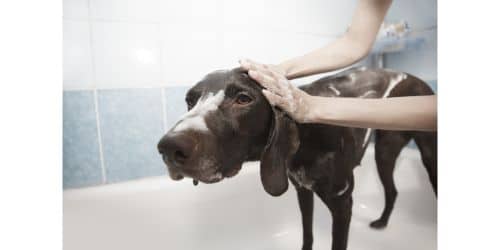Dogs, our cherished animal pals, are prone to a variety of health problems, including ophthalmic diseases. One such concern is corneal ulcer, a painful condition that damages the translucent outer layer of the eye. In this comprehensive blog post, we will define a corneal ulcer in a dog, investigate their causes and symptoms, and cover treatment choices to ensure your canine pet receives the best possible care.
Corneal Ulcer in Dogs: What You Need to Know
Corneal ulcer, also known as corneal abrasion or ulcerative keratitis, is characterized by the erosion or loss of the corneal epithelium—the cornea’s outer layer. The cornea serves as a protective barrier and is essential for preserving clean eyesight. If left untreated, a corneal ulcer exposes the underlying layers of the cornea, causing irritation, inflammation, and serious consequences.
Causes of Corneal Ulcers in Dogs
Corneal ulcers in dogs can be caused by a variety of factors, including:
- Trauma: Scratches to the eye, foreign bodies, or exposure to irritants such as chemicals can all cause corneal damage and ulcers.
- Infections: Bacterial, viral, or fungal infections, such as herpesvirus, or bacteria such as Pseudomonas, can contribute to the formation of corneal ulcers.
- Dry Eye (Keratoconjunctivitis Sicca): Inadequate tear production can cause corneal dryness and irritation, rendering it more vulnerable to injury and ulceration.
- Eyelid Abnormalities: Conditions such as entropion (inward rolling of the eyelids) and ectropion (outward sagging of the eyelids) can cause chronic corneal irritation, resulting in ulcers.
- Breeds Predisposition: Due to their distinctive face morphology, certain dog breeds, such as Pugs, Bulldogs, and Shih Tzus, are more prone to corneal ulcers.
Understanding the Symptoms of Corneal Ulcers
The detection of corneal ulcers in dogs at an early stage is critical for timely intervention and efficient treatment. By becoming informed of the signs and symptoms, you will be able to seek veterinarian care as soon as possible and give your canine companion the attention they require. Here are some significant factors to keep an eye out for:
#1. Excessive Blinking or Squinting:
Dogs with corneal ulcers frequently squint or blink excessively in an attempt to relieve pain and protect the afflicted eye. If you see your dog squinting or blinking more than usual, this could be an indication of corneal ulcers.
#2. Redness or Inflammation of the Eye:
Corneal ulcers can make the eye red and irritated. On the surface of the eye, you may notice apparent redness or enlarged blood vessels. If you see any odd redness or irritation in your dog’s eyes, you must have them evaluated by a veterinarian.
#3. Excessive Tearing or Discharge:
As the eye attempts to protect and lubricate the damaged cornea, dogs with corneal ulcers may experience increased tear production. Excessive tearing or a watery discharge from the afflicted eye may occur. It is critical to distinguish between regular tear production and aberrant discharge, which could signal an underlying problem.
#4. Rubbing or Pawing at the Affected Eye:
As a reflexive reaction, dogs in pain frequently paw or rub at their eyes. If you notice your dog pawing or rubbing at one eye regularly, it could be an indication of pain or irritation caused by a corneal ulcer.
#5. Corneal Cloudiness or Opacity:
A corneal ulcer can obscure or make the ordinarily transparent cornea opaque. On the surface of the eye, you may observe a haze or a whitish look. This cloudiness indicates ocular injury and necessitates prompt veterinarian intervention.
#6. Light Sensitivity (Photophobia):
Dogs suffering from corneal ulcers are frequently sensitive to bright light. They may avoid well-lit areas or experience discomfort when exposed to sunshine or other bright lights. If your dog exhibits signs of light sensitivity, they may have a corneal ulcer.
#7. Decreased Appetite or Lethargy (in severe cases):
Dogs with severe corneal ulcers may have a drop in appetite and general energy levels. The condition’s soreness and discomfort might cause tiredness and a loss of interest in food. If your dog exhibits these symptoms, as well as any other signs of corneal ulcers, they should seek emergency veterinary assistance.
Corneal Ulcer Dog Treatment
The major purpose of corneal ulcer treatment in a dog is to promote healing, ease pain, and prevent additional problems. The specific treatment technique will be determined by the severity of the ulcer, the underlying cause, and the dog’s overall health. Let’s look at the numerous treatment options for corneal ulcers in a dog:
#1. Topical Medications:
In most cases, topical medicines are the primary treatment for a corneal ulcer in a dog. Antibiotic eye drops or ointments are frequently used by veterinarians to prevent or treat secondary bacterial infections that can further damage the already weakened cornea. These medications may need to be given numerous times every day for a set period, as prescribed by the veterinarian.
#2. Pain Control:
Corneal ulcers in dogs can cause substantial discomfort and anguish. Veterinarians may prescribe analgesics or nonsteroidal anti-inflammatory drugs (NSAIDs) to relieve their pain. During the healing process, these drugs serve to reduce inflammation, relieve pain, and improve the dog’s general comfort.
#3. Protective Measures:
It is critical to preserve the injured eye to prevent further trauma and facilitate healing. To keep the dog from rubbing or scratching the eye, veterinarians may propose the use of an Elizabethan collar (sometimes known as the “cone of shame”). Protective goggles or other protective devices may also be used to protect the eye during outdoor activities or when there is a risk of future harm.
#4. Underlying Causes Management:
If an underlying condition, such as dry eye (keratoconjunctivitis sicca) or irregularities in the eyelids, contributes to the formation of corneal ulcers, these issues must be addressed. Artificial tears, lubricating ointments, or drugs that encourage tear production may be used to treat dry eyes. Eyelid irregularities may necessitate surgical treatment to prevent corneal discomfort.
#5. Nutritional Support:
A well-balanced and healthy diet can help with general eye health and the healing process. Consult your veterinarian to ensure that your dog is receiving a proper diet as well as any supplements that enhance ocular health.
#6. Follow-up Care and Monitoring:
Corneal ulcers must be monitored on an ongoing basis to ensure adequate healing. Regular veterinary visits are required to examine the ulcer’s development, change the treatment strategy as appropriate, and monitor for any potential consequences. During these visits, the veterinarian may perform further tests, such as fluorescein staining or corneal cytology, to assess the healing process and treatment success.
#7. Surgical Procedure:
When traditional treatment procedures fail to produce the desired effects in severe cases of a corneal ulcer in a dog, surgical intervention may be required. Corneal grafting, in which a healthy donor cornea is transplanted onto the ulcerated area, or conjunctival flap surgery, in which a protective flap from the conjunctiva is created to cover the ulcer and encourage healing, are surgical alternatives for dogs with corneal ulcers. These treatments are normally carried out by veterinary ophthalmologists and necessitate particular knowledge.
It is vital to remember that the treatment technique for a corneal ulcer in a dog will differ depending on the individual cases. As a result, it is critical to consult a veterinarian who can evaluate your dog’s illness and offer the best treatment plan. Prompt and effective treatment will greatly improve your dog’s chances of a successful recovery and restore his visual health.
In the next section, we will discuss additional advanced treatment options that may be employed in certain cases of corneal ulcers in dogs.
Immediate First Aid for Corneal Ulcer in Dog
There are a few actions you may do to provide initial first aid for your dog’s corneal ulcer while awaiting veterinarian care:
- Prevent further trauma: Limit your dog’s activity and keep them from rubbing or scratching the injured eye to avoid further stress.
- Avoid medications: Avoid administering over-the-counter drugs or ointments without veterinary supervision, since they might exacerbate the illness.
- Keep the eye clean: Gently wipe away any discharge or debris around the eye with a damp, clean cloth.
Conventional Treatment Approaches
A mix of medicinal therapies customized to the unique condition is usually required for the effective treatment of a corneal ulcer in a dog. The following may be included in the treatment plan:
- Topical Medications: Antibiotic eye drops or ointments are frequently recommended to prevent or treat secondary infections and aid recovery.
- Pain Management: Analgesics or nonsteroidal anti-inflammatory drugs (NSAIDs) may be prescribed to relieve pain and inflammation.
- Protective Measures: To prevent self-trauma, an Elizabethan collar or other protective measures may be required to shield the eye throughout the healing period.
- Management of Underlying Causes: If the corneal ulcer is linked to an underlying problem, such as dry eye, suitable therapies to address the core cause will be undertaken.
Advanced Treatment Options
Corneal ulcer in a dog may necessitate more complex treatment methods in some circumstances, such as:
- Surgical Intervention: If the ulcer is severe, deep, or not responding to standard treatment, surgical treatments such as corneal grafting or conjunctival flap may be performed to promote healing.
- Tissue Glues or Bandage Contact Lenses: These specialist techniques can provide additional protection and support to the cornea as it heals.
Home Care and Preventive Measures
It is critical to give correct home care for your dog’s corneal ulcer after obtaining veterinary treatment. Follow the following guidelines:
- Administer Medications as Directed: Follow your veterinarian’s instructions for administering any recommended medications, including topical eye drops or ointments.
- Protect the Eye: Use an Elizabethan collar or other protective measures to keep your dog from rubbing or scratching the affected eye.
- Monitor for Improvement: Keep an eye on your dog’s progress and search for indicators of improvement, such as reduced redness, more comfort, and a clearer cornea.
- Follow-up Veterinary Visits: Attend scheduled follow-up appointments to assess healing progress and make any required treatment plan changes.
Consider the following preventive strategies to reduce the risk of corneal ulcers in the future:
- Regular Eye Examinations: Schedule routine eye examinations with your veterinarian to discover any early signs of eye disorders and treat them as soon as possible.
- Prevent Trauma: Make efforts to avoid eye injuries, such as wearing protective eyewear during potentially hazardous activities.
- Maintain Good Eye Hygiene: Gently wipe your dog’s eyes regularly to remove dirt and prevent irritation buildup that could lead to corneal injury.
- Address Underlying Conditions: If your dog has an underlying condition, such as dry eyes or atypical eyelids, work together with your veterinarian to properly address these conditions.
When to Consult a Veterinarian
While home care is necessary, knowing when to seek veterinarian aid is critical. If you see any of the following symptoms, contact your veterinarian:
- Your dog’s condition worsens or does not improve despite treatment.
- Your dog is displaying symptoms of extreme discomfort, suffering, or systemic sickness.
- The corneal ulcer appears to be deep or has not healed in the timeframe expected.
- You have any concerns or questions regarding your dog’s recovery.
What is a corneal ulcer?
A corneal ulcer is a painful and potentially dangerous disorder characterized by the erosion or loss of the cornea’s outermost layer, which is the transparent, dome-shaped tissue that covers the front of the eye. The cornea is important in vision because it refracts light onto the lens and retina. A corneal ulcer occurs when the cornea becomes injured or forms an open sore.
What are the symptoms of a corneal ulcer?
Depending on the severity of the ulcer and the underlying cause, the symptoms of a corneal ulcer in dogs can vary. Here are some common indications and symptoms to keep an eye out for:
- Squinting or excessive blinking
- Redness and inflammation
- Excessive tearing or discharge
- Pawing or rubbing at the eye
- Cloudiness or opacity of the cornea
- Sensitivity to light (photophobia)
- Decreased appetite or lethargy (in severe cases)
How is a corneal ulcer treated in dogs?
The treatment of a corneal ulcer in a dog is determined by the severity of the ulcer, the underlying cause, and the state of the particular dog. Veterinarians commonly use the following treatment options:
- Topical Medications
- Pain Management
- Protective Measures
- Management of Underlying Causes
- Nutritional Support
- Follow-up Care and Monitoring
- Surgical Intervention
Can a dog corneal ulcer heal on its own?
Most corneal ulcers heal in a few days as the epithelium regenerates from the ulcer’s margins and extends over the defect. However, in some dogs, this healing process may not take place, and they acquire an SCCED.
How long does it take for a corneal ulcer to heal in a dog?
Between one and two weeks
The healing duration is determined by factors such as the source of the ulcer, its size, location, and depth. After treatment begins, the healing process normally takes one to two weeks, but in more challenging situations, it can take many months.
What is the best antibiotic for corneal ulcer dogs?
For regular ulcers, use broad-spectrum antibiotics, such as Tricin eye ointment (Neomycin, Bacitracin, Polymyxin). Strong antibiotics, such as gentamicin, are not recommended unless there is evidence of infection, such as excessive ocular discharge or darkening of the corneal stroma.
What helps corneal ulcers heal faster?
Antibiotic, antiviral, or antifungal eye drops are usually required right away and must be used regularly, often every hour around the clock for several days. Eye drops that dilate the pupil, such as atropine or scopolamine, can alleviate pain and lessen the likelihood of problems.
Conclusion
Corneal ulcer in a dog can be a stressful ailment, but the prognosis is often favorable with early discovery and immediate treatment. Remember to visit your veterinarian for an accurate diagnosis and treatment plan that is suited to your dog’s individual needs. You may assist in ensuring your furry companion’s comfort, encourage recovery, and protect their valuable eyesight by providing the required care.
Maintaining regular veterinary check-ups, practicing excellent eye care, and taking preventative measures to limit the danger of corneal ulcers are all ways to prioritize your dog’s ocular health. You may help your dog enjoy a clear and vibrant world with healthy, bright eyes with your dedication and the knowledge of your veterinarian.
Related Articles
- Allergic Conjunctivitis In Dogs: Causes, Symptoms, and Treatment
- What is the Best Flea Treatment for Puppies Under 12 Weeks?
- Best Ear Mite Treatment For Cats In 2023
- HOW TO PREVENT AND KEEP TICK OFF DOGS: Best Treatments and Remedies
- VALLEY FEVER IN DOGS: Symptoms, Treatment and Natural Remedies






